
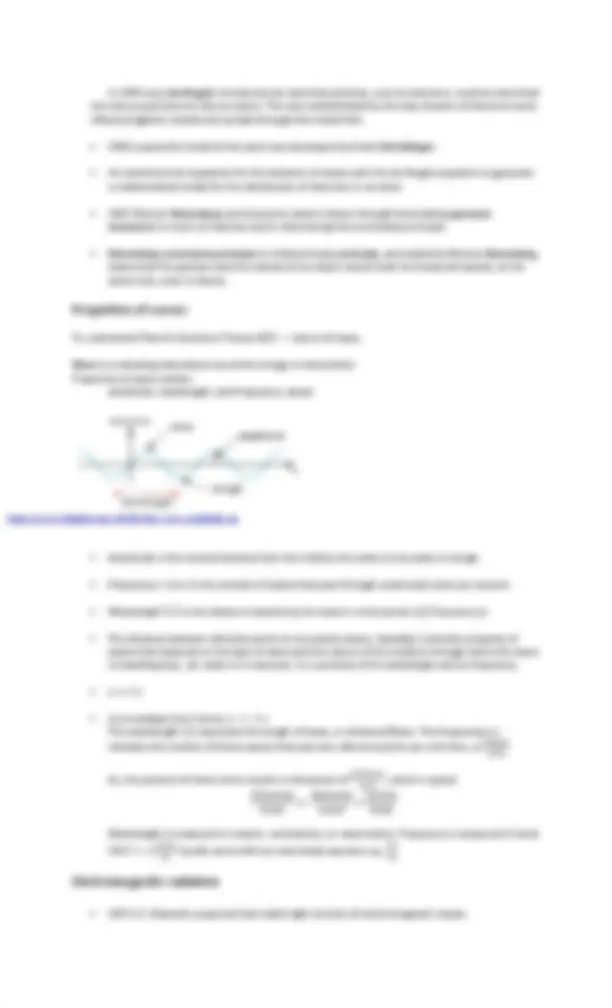
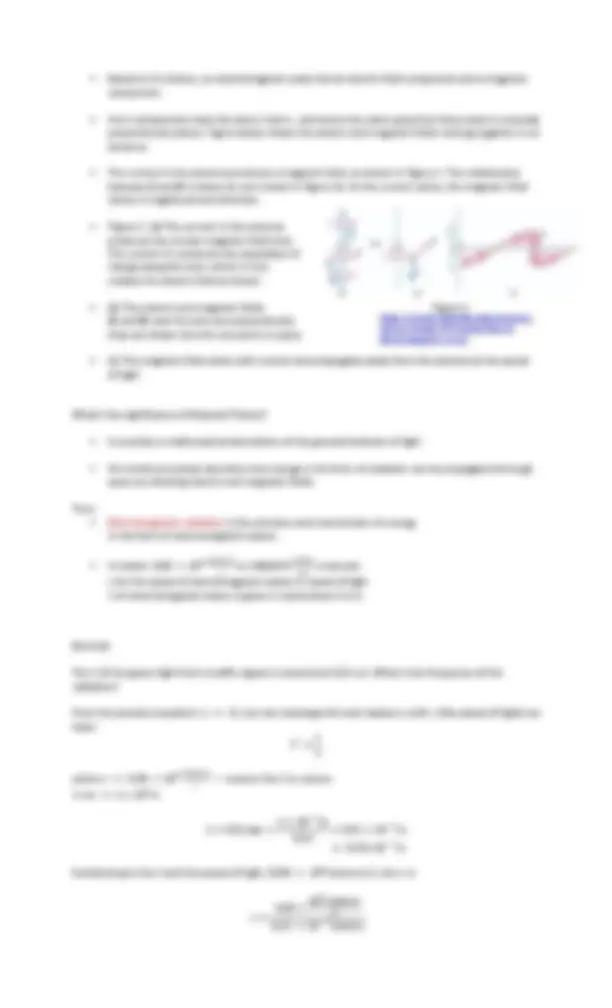

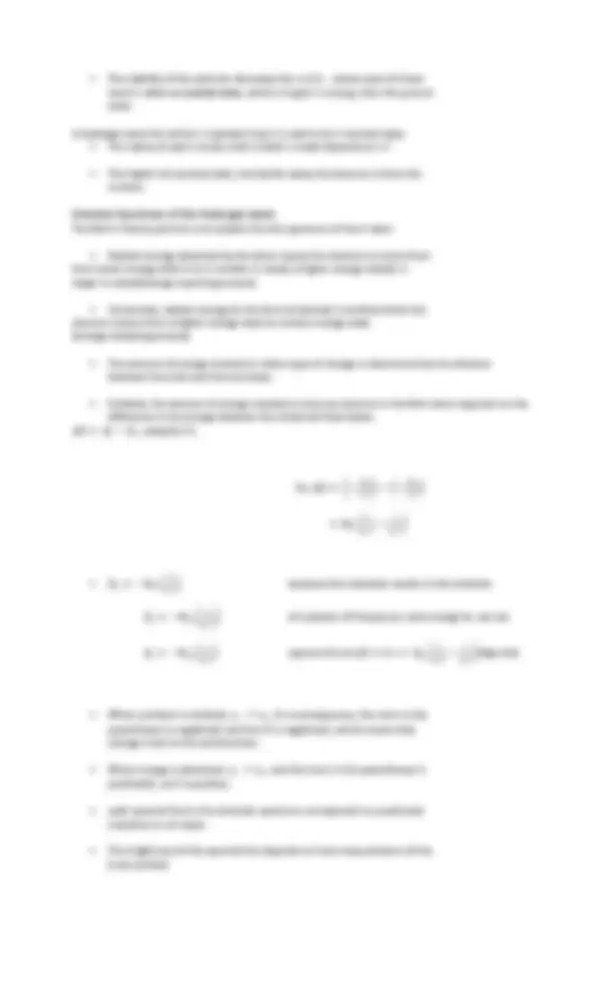
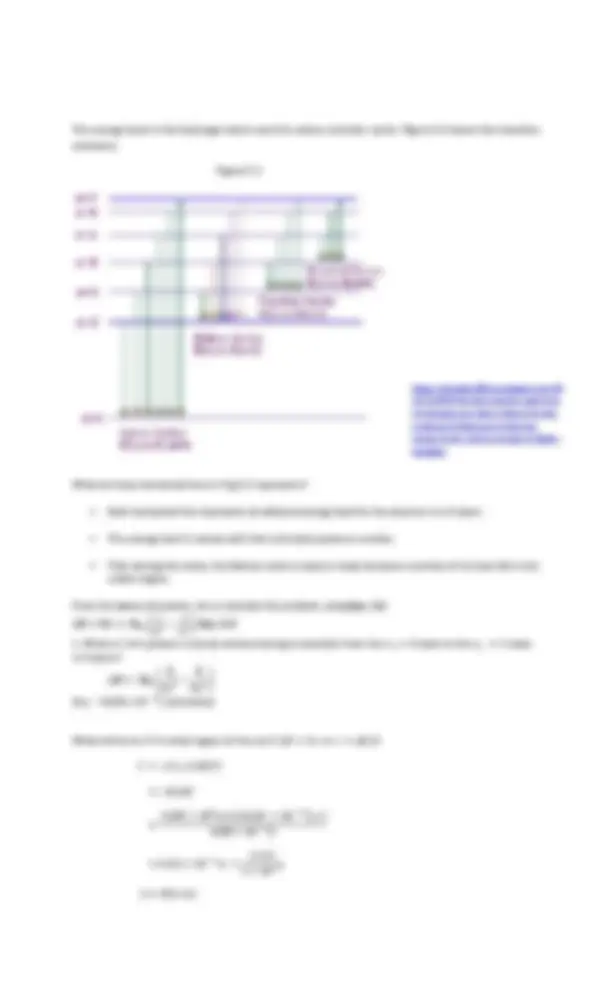

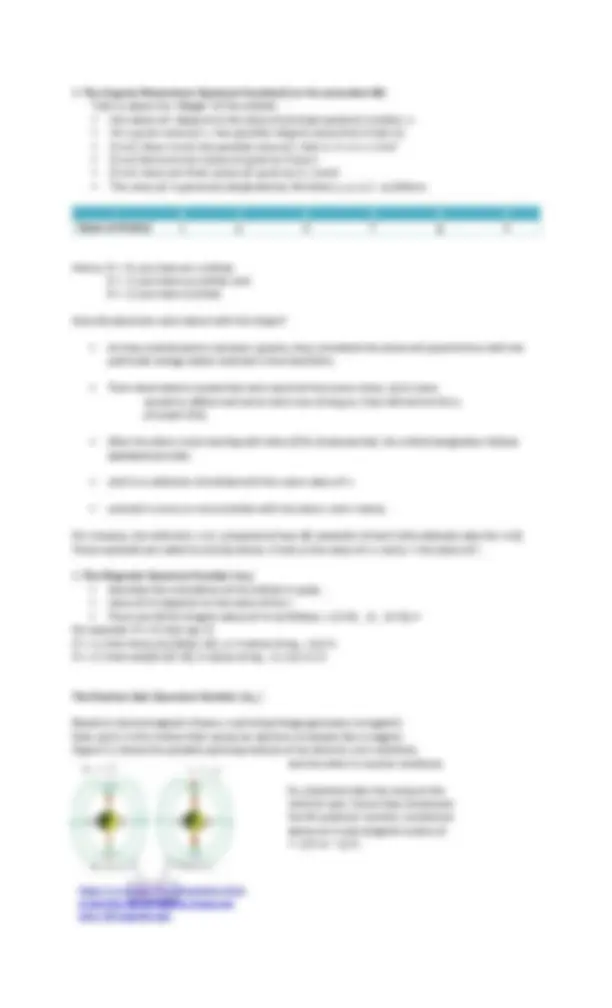
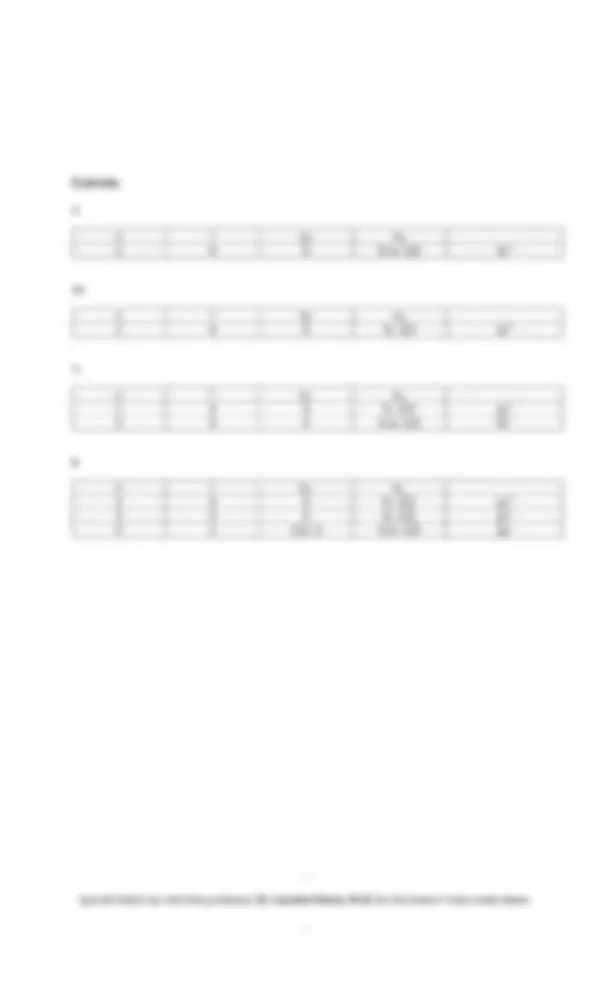


Study with the several resources on Docsity

Earn points by helping other students or get them with a premium plan


Prepare for your exams
Study with the several resources on Docsity

Earn points to download
Earn points by helping other students or get them with a premium plan
Community
Ask the community for help and clear up your study doubts
Discover the best universities in your country according to Docsity users
Free resources
Download our free guides on studying techniques, anxiety management strategies, and thesis advice from Docsity tutors
I got these notes from my 1ST YEAR COLLEGE CHEMISTRY CLASS discussions. These lessons will teach you about the following: 1. Trace the development of quantum theory 2. Quantum theory (in general or as introductory). 3. The Properties of Waves 4. Electromagnetic Radiation 5. Plank's Theory 6. Photoelectric Effect
Typology: Lecture notes
1 / 14

This page cannot be seen from the preview
Don't miss anything!









Inorganic Chemistry CHEM 110 Western Mindanao State University (WMSU)
Note about:
Objectives: At the end of this session, you can:
▪ What is quantum?
Quantum is the Latin word for amount and it means the smallest possible discrete unit of any
physical property, such as energy or matter.
▪ 19th century early attempts by physicists to understand atoms were met with
limited success
▪ they assume that molecules behave like rebounding balls,
▪ physicists were able to predict and explain some macroscopic phenomena, e.g., pressure
exerted by gas.
▪ limitation of this model- did not account for the stability of molecules, i.e., could not explain the
forces that hold atom together
▪ years to realize and accept- that the properties of atoms and molecules not governed by the
same physical laws as larger objects.
▪ 1900 - new era in physics started. Planck while analyzing the data on radiation emitted by solids
heated at various temperature, discovered that atoms and molecules emit energy only in certain
discreet quantities or “quanta” and
▪ physicists had always assumed that energy is continuous an it any amount of energy could be
released in a radiation process.
Niels Bohr and Max Planck , are two of the founding fathers of Quantum Theory, each
received a Nobel Prize in Physics for their work on quanta. Max Planck study the effect of
radiation on a “blackbody” substance, and the quantum theory of modern physics is born.
o Planck demonstrated that energy, in certain situations, can exhibit
characteristics of physical matter.
Bohr’s - the atomic model :
It shows the atom as a small, positively charged nucleus surrounded by orbiting electrons.
o theory of atomic structure in which the hydrogen atom ( Bohr atom ) is assumed to
consist of a proton as nucleus with a single electron moving in distinct circular orbits
around it. Each orbit corresponding to a specific quantized energy state: the theory was
extended to other atoms.
It is commonly known that light somehow consists both of light waves and also particle-like
photons. The notion of these photons comes from quantum theory (and from Einstein directly,
who first introduced them in 1905 as “light quanta”).
o Einstein is considered the third founder of Quantum Theory because he described light
as quanta in his theory of the photoelectric effect, for which he won the 1921 Nobel
Prize.
Quantum theory
o 1905, Albert Einstein explained the photoelectric effect by postulating that light, or
more generally all electromagnetic radiation (emr), can be divided into a finite number
of “energy quanta” that are localized points in space. They are collectively known as the
quantum theory.
https://courses.lumenlearning.com/suny-
physics/chapter/24- 2 - production-of-
electromagnetic-waves/
▪ Based on his theory, an electromagnetic wave has an electric field component and a magnetic
component.
▪ the 2 components have the same 𝜆 and 𝑣, and hence the same speed but they travel in mutually
perpendicular planes. Figure below shows the electric and magnetic fields moving together in an
antenna.
▪ The current in the antenna produces a magnetic field, as shown in Figure 1. The relationship
between E and B is shown at one instant in Figure 1a. As the current varies, the magnetic field
varies in magnitude and direction.
▪ Figure 1. (a) The current in the antenna
produces the circular magnetic field lines.
The current (𝐼) produces the separation of
charge along the wire, which in turn
creates the electric field as shown.
▪ (b) The electric and magnetic fields Figure 1
( E and B ) near the wire are perpendicular;
they are shown here for one point in space.
▪ (c) The magnetic field varies with current and propagates away from the antenna at the speed
of light
What's the significance of Maxwell Theory?
▪ It provides a mathematical description of the general behavior of light.
▪ His model accurately describes how energy in the form of radiation can be propagated through
space as vibrating electric and magnetic fields.
Thus:
▪ Electromagnetic radiation is the emission and transmission of energy
in the form of electromagnetic waves.
▪ It travels 3. 00 × 10
8
𝑚𝑒𝑡𝑒𝑟𝑠
𝑠
or 186 , 0 𝑂𝑂
𝑚𝑖𝑙𝑒𝑠
𝑠𝑒𝑐
a vacuum.
𝑐 for the speed of electromagnetic waves or speed of light
𝜆 of electromagnetic waves is given in nanometers
Exercise:
The 𝜆 of the green light from a traffic signal is centered at 522 𝑛𝑚. What is the frequency of this
radiation?
From the previous equation: 𝑢 = 𝜆𝑣; we can rearrange this and replace 𝑢 with 𝑐 (the speed of light) we
have:
where 𝑐 = 3. 00 × 10
8
𝑚𝑒𝑡𝑒𝑟𝑠
𝑠
— convert the 𝜆 to meters
9
𝜆 = 522 nm ×
− 9
− 9
− 7
Substituting in the 𝜆 and the speed of light, ( 3. 00 × 10
8
𝑚𝑒𝑡𝑒𝑟𝑠/𝑠), the 𝑣 is
8
− 7
https://www.uib.no/en/hms-
portalen/75292/electomagnetic-spectrrum
10
14
𝑠
or 5. 75 × 10
14
This means that 5. 75 × 10
14
𝐻𝑧 waves passed a fixed point every second, which is in accordance to the
speed of light.
Figure 2 shows
▪ long radio waves are
emitted by large
antennas-
broadcasting stations
▪ shorter visible light
waves are produced by
the motions of
electrons
within atoms and
molecules.
▪ shortest waves, which
also have the highest
frequency, are
associated with gamma (γ) rays, Figure 2
which result from changes
within the nucleus of
the atom.
Note: the higher the frequency, the more energetic the radiation.
▪ UV radiation, X-rays and γ are high-energy radiation.
Light bulb (tungsten) - emits bright white light.
Electric heater - emits dull red.
Measurement taken in the latter part of the 19th century, showed that the amount of the radiation
energy emitted by an object at a certain temperature depends on its wavelength.
But, dependence on its wavelength whether its short or long became a problem and they could not
account and they surmise that a bask thing missing from the laws of classical physics.
▪ Planck solved the problem, where he said that atoms and molecules could emit (or absorb)
energy only in discrete quantities (like small packages or bundles).
▪ named quantum to the smallest quantity of energy that can be emitted (or absorb) in the form
of electromagnetic radiation.
▪ The energy 𝐸 of a single quantum of energy is expressed as:
where: ℎ is the Planck's constant 6. 63 × 𝑙𝑂
− 34
𝐽. 𝑠, 𝑣 is the frequency of the radiation
▪ Based on quantum theory, energy is always emitted in multiples of ℎ𝑣.
Example, 1ℎ𝑣, 2ℎ𝑣,3ℎ𝑣... but cannot be, for example, 1 .67ℎ𝑣 or 4. 98 ℎ𝑣.
1905, Albert Einstein used this theory to solve another breakthrough in
physics.
Objective/s: At the end of the discussion, you can:
In 1913, after Planck and Einstein, a theoretical explanation of the
emission spectrum of the H atom was presented by Bohr.
Recall the structure of an atom (protons, neutrons and electrons).
In Bohr’s theory of the Hydrogen atom includes the following:
from a higher energy-orbit to a lower one and giving up of a quantum energy
(a photon) in the form of light. The figure below shows the line emission
spectra of hydrogen atom.
Based on electrostatic attraction and Newton’s laws of motion, Bohr showed
that the energies that the electron in the H atom can possess are given by:
Eq. 5.1 𝐸
𝑛
𝐻
(𝑙/𝑛), where 𝑅
𝐻
, the Rydberg constant 2. 18 × 10
− 18
𝑛 is an integer called the principal
quantum number, it has the values 𝑛 1,2,3…
the negative sign is an arbitrary convention, signifying that the energy of
electron in the atom is lower than energy of the free electrons — electrons that
are infinitely far from the nucleus.
▪ Energy of free electrons is arbitrarily assigned 0 value of zero.
▪ As the electron gets closer to the nucleus (as 𝑛 decreases), 𝐸
𝑛
becomes
larger in absolute value, but also more negative.
▪ The most negative value, then, is reached when 𝑛=1, which correspond
to the most stable energy State — ground state , which refers as the
lowest energy state of a system (H).
https:llwww.khanacademy.org/science/class11chemistryindia/xfbb6cb8fc2b
d00c8:ininstructur-of-atom/xfbb6cb8fc2bd00c8:in-
inbohrsmodelofhydrogenatom/a/absorptionemission-lines
▪ The stability of the electron decreases for 𝑛=2,3... where each of these
level is called an excited state , which is higher in energy thon the ground
state.
A hydrogen atom for which n is greater than 1 is said to be in excited state.
▪ The radius of each circular orbit in Bohr’s model depends on 𝑛
2
▪ The higher the excited state, the farther away the electron Is from the
nucleus.
The Bohr’s theory permits us to explain the line spectrum of the H atom
▪ Radiant energy absorbed by the atom causes the electron to move from
from lower energy-state to (𝑛 is smaller in value) a higher energy-state(𝑛 is
larger in value)(energy requiring process)
▪ Conversely, radiant energy (in the form of photon) is emitted when the
electron moves from a higher-energy state to a lower energy-state
(energy-releasing process)
▪ The amount of energy involved in either type of change is determined by the distance
between the start and the end steps.
▪ Similarly, the amount of energy needed to move an electron in the Bohr atom depends on the
difference in the energy between the initial and final states.
𝑓
𝑖
, using Eq 5.
So, ∆𝐸 = (−
𝑅
ℎ
𝑛
𝑓
2
𝑅
ℎ
𝑛
𝑖
2
𝐻
1
𝑛 𝑖
2
1
𝑛 𝑓
2
𝑛
𝐻
1
𝑛
2
) because this transition results in the emission
𝑓
𝐻
1
𝑛
𝑓
2
) of a photon of frequency v and energy hv, we can
𝑖
𝐻
1
𝑛
𝑖
2
) express this as ∆𝐸 = ℎ𝑣 = 𝑅
𝐻
1
𝑛
𝑖
2
1
𝑛
𝑓
2
) Eqn. 5.
▪ When a photon is emitted, 𝑛
1
𝑓
. As a consequence, the term in the
parentheses is negative(-) and the 𝐸 is negative(-), which means that
energy is lost to the environment.
▪ When energy is absorbed, 𝑛
1
𝑓
, and the term in the parentheses is
positive(+), so 𝐸 is positive.
▪ each spectral line in the emission spectrum corresponds to a particular
transition in a H atom.
▪ The brightness of the spectral line depends on how many photons of the
λ are emitted
Objectives: At the end of the session, you can:
Recall: Bohr’s theory!
Physicists were puzzled and question Bohr’s theory, that is, why is the electron in a H atom restricted to
orbiting the nucleus at certain fixed distances? Or simply why the energies of the H atom are quantized?
▪ Bohr could not offer an explanation of his theory.
▪ 1924, de Brogue offered an explanation to this query, that is,
▪ If light waves can behave like a stream of particles (photons), then maybe particles like electrons
can possess wave properties.
Broglie avers that an electron bound to the nucleus behaves like s tanding waves (generated by plucking
a guitar string) called as such because such waves do not travel along the string.
▪ Nodes1 points on the string do not move at all, that is the amplitude of the
wave at this point is zero. (exists at each end or may be between the end).
number of nodes.
▪ de Broglie argued that if an electron does behave like a standing wave in the H atom, the length
of the wave must fit the circumference of the orbit exactly, or otherwise the wave would
partially cancel itself on each successive orbit. Eventually the amplitude of the wave would be
reduced to zero, and the wave would not exist.
of the electron is expressed as:
where: r is the radius of the orbit
𝑛 is 1,2, ...
▪ Because n is an integer, it follows that r can hove only certain values as n increases from 1 to 2 to
▪ Because the energy of the electrons depends on the size of the orbit (value of r), its value must
be quantized.
▪ This reasoning led de Broglie to conclude that waves can behave like particles and particles can
exhibit wavelike properties.
▪ de Brogue deduced that the particle and wave properties are related by the expression
𝜆 = ℎ/𝑚𝑢 Eqn. 5.
where: 𝜆 = wavelengths
𝑚 = mass
𝑢 = velocity
Eqn 5.3 tells us that a particle in motion can be treated as a wave, and a wave can exhibit the
properties of a particle
Answer this.
Using Eqn. 5.3, calculate the 𝜆 of the " particle" in the following two (2) cases. a) the fastest
serve in tennis s about 140 miles/hour, or 63m/s. Calculate the 𝜆 associated with a
− 2
𝑘𝑔 tennis ball travelling at this speed, b) Calculate the 𝜆 associated with an
electron ( 9. 1094 𝑥 10
31
𝑘𝑔) moving at 63m/s.
Objectives: At the end of this topic, you can:
Weaknesses of Bohr’s theory
and Li)
applied.
“position” of a wave be specified. Strength: He theorized that energy of an electron in an atom
is quantized (which remains unchallenged)
To solve the problem of the position or location of electron that behaves like a wave-
▪ Werner Heisenberg formulated this idea known as the Heisenberg Uncertainty Principle that
states: it is impossible to know simultaneously both the momentum 𝑝 (𝑚 𝑥 𝑣𝑒𝑙𝑜𝑐𝑖𝑡𝑦) and the
position of a particle with certainty. Mathematically expressed as:
𝛥𝑝 𝛥𝑝 ≥ ℎ/ 4 𝜋𝑟 Eqn.5.
where: Δ x and Δp are the uncertainties in measuring the position and
momentum.
▪ Eqn. 5.4 tells us that if we make Δp a small quantity- our knowledge of the position will become
correspondingly less precise ( that is Δx will become larger). In like manner, if the position of the
particle is known more precisely, then its momentum measurement must be less precise.
▪ If we apply Heisenberg uncertainty principle to H atom, it is observed in reality the electron does
not orbit in the nucleus in a well-defined path, as what Bohr thought.
▪ If it did, we could determine both the position of the electron (from the radius of the orbit) and
its momentum (from its k.e.) at the same time a violation of the uncertainty principle.
Erwin Schrödinger
▪ 1926 Erwin Schrödinger using a complicated mathematical technique formulated an equation
that describes the behavior and energies of submicroscopic particles in general, an equation
analogous to Newton’s laws of motion for macroscopic objects.
▪ His equation incorporates both particle behavior, in terms of mass m , and wave behavior in
terms of a wave function Ψ (psi), which depends on the location in space of the system (such an
electron in an atom).
In his mind, the wave function itself has no direct physical meaning
Tells us about the "shape" of the orbitals
▪ the values of I depend on the value of principal quantum number, n.
▪ For a given value of n, l has possible integral values from 0 to(n-1).
▪ If n=3, there is only one possible value of I; that is. l= n-1 = 1-1=
▪ If n=2 there are two values oil given by 0 and 1.
▪ If n=3, there are three values of l given by 0, 1 and
▪ The value of l is generally designated by the letters s, p, d, f...as follows:
l 0 1 2 3 4 5
Name of Orbital s p d f g h
Hence, if l = 0, you have an s orbital;
If l = 1, you have a p orbital, and
If l = 2, you have d orbital
How did physicists come about with this shape?
▪ As they studied atomic emission spectra, they correlated the observed spectral lines with the
particular energy states involved in the transitions.
▪ Their observations reveal that some spectral lines were sharp , some were
spread or diffuse and some were very strong so, they referred to this a
principal lines.
▪ After the letter d and starting with Ietter f ( for fundamental ), the orbital designation follows
alphabetical order.
▪ shell is a collection of orbitals with the same value of n.
▪ subshell is a one or more orbitals with the same n and l values.
For instance, the shell with n =2, composed of two (2) subshells l =0 and 1 (the allowed value for n =2).
These subshells are called 2 s and 2 p where: 2 tells us the value of n s and p = the values of l.
𝒍
▪ describes the orientation of the orbital in space.
▪ value of ml depends on the value of the l ,
▪ There are (2 l +1) integral values of ml as follows: - I ,(- l +1)... 0,...(+ I - 1),+ I
For example: if l = 0, then 𝒎 𝒍
If l = 1, then there are [(2x1) +1)], or 3 values of 𝒎 𝒍
if l = 2, there are[(2 x2) +1)], 5 values of 𝒎 𝒍
The Electron Spin Quantum Number ( 𝒎
𝒔
Based on electromagnetic theory, a spinning charge generates a magnetic
field, and it is this motion that causes an electron to behave like a magnet.
Figure 5.1 shows the possible spinning motions of an electron, one clockwise,
and the other is counter clockwise.
So, physicists take into account the
electron spin, hence they introduced
the 4 h quantum number, mentioned
above as m and assigned a value of
https://www.toppr.com/ask/question/which-
of-the-following-has-negative-charge-and-
pairs-with-opposite-spin/
𝑙
𝑠
1 0 0 ½ or - 1/2 1 𝑠
1
He
𝑙
𝑠
2
Li
𝑙
𝑠
2
2 0 0 ½ or - 1/2 2 𝑠
1
𝑙
𝑠
2
2
2 1 - 1,0, - 1 ½ or - 1/ 2 𝑝
1
Special thanks my chemistry professor, Dr. Lourdes Filoteo, Ph.D. for the lessons I have noted above.